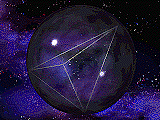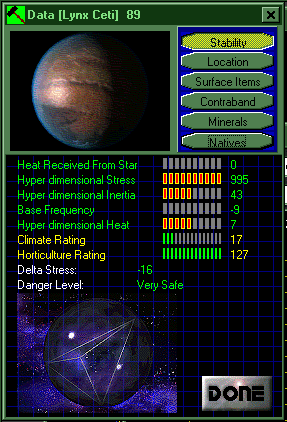|

Jan 28th, 2004
from
VGAPlanets Website
The rotation of matter sets up a 11
dimensional scalar wave in hyperspace. The scalar wave has a rising,
falling or steady base frequency. The hyper dimensional energy is
converted to heat at the focal points of the of the 5th dimensional
tetrahedral flex wave at one of the three tetrahedral / sphere
intersection points. These points are located at 19.5 degrees away
from either the north or south axis of rotation.
These focal points
result in hot spots on the planets surface that can lead to island
building in a planets oceans or volcanic activity on its land
masses. Gas giants tend to form large powerful storms over these hot
spots.

There are three important factors to remember when dealing with
planets.
-
Hyper dimensional stress
Hyper dimensional stress is measured in Hoaglands. When the
stress level of a planet exceeds 1000 Hoaglands there is a
danger that the planet will explode from a cascading scalar wave
feedback resonance.
-
Hyper dimensional inertia
The resistance to a change in the planets base frequency. The
higher the inertia the less likely the base frequency will
change. The inertia is determined by the elements that make up
the planets core. Planets with a copper core have high inertia,
planets with a nickel or iron core have a very low inertia and
tend to be unstable. Inertia allows the planet to produce heat,
warming the planets climate.
-
Hyper dimensional base frequency
The amount of energy that is added to the pool of hyper
dimensional stress that the planet already has.
Planet Data
Pad

Heat Received From Star = 0
This planet receives no heat from its star. The star at the center
of this system happens to be a neutron star. Neutron stars happen to
be very cool, producing almost no heat.
Hyper dimensional Stress = 995
This is an very high stress level. If this planet had just 5 more
stress units it would be in danger of exploding.
Hyper dimensional Inertia = 43
The inertia level of a planet ranges from a low of 0 to a high of
100.
Base Frequency = -9
A negative frequency causes the planet decrease in stress each turn.
This planet loses 9 stress points from having a negative base
frequency. A positive base frequency adds to the stress level of the
planet.
Hyper dimensional Heat = 7
The hyper dimensional inertia of the planet allows this planet to
produce 7 units of heat. This extra heat can sometimes cause a
slight change in the climate of the planet.
Climate Rating = 17
A climate rating of 17 is considered very cold.
Horticulture Rating = 127
This planet can support up to 127 farms. Only races that are able to
farm on very cold planets would be able to grow crops on this
planet. Races that can not produce food on a planet with a climate
of 17 will need to terraform the planet to increase the climate to a
rating that the race is able to farm in. Most races need a climate
between 40 and 60 to grow food.
Delta Stress = -16
This is the rate of change per turn of the stress level of the
planet.
Danger Level =
Risky, Planet may explode within 200 turns
Very High, Planet may explode within 40 turns
Extreme!, Planet may explode within 10 turns
Safe, Planet will not explode
Very Safe, Planet will not explode
A planet with a negative delta stress is not likely to explode any
time soon.
The Crystals are well know for their ability to transform HD Stress
into usable goods using a very special device know as a Hyper Lathe,
that device makes anything from ord to food units. If you find
yourself at war with a member of the Crystal race, remember that the
more worlds that he controls with a high HD Stress the more food and
ord units he will produce and the stronger he will become and the
more of he very nasty minefields you will have to deal with..
A planet with a hyper dimensional stress level of more than 100 will
produce new metals in the planet's core at these levels:
|


